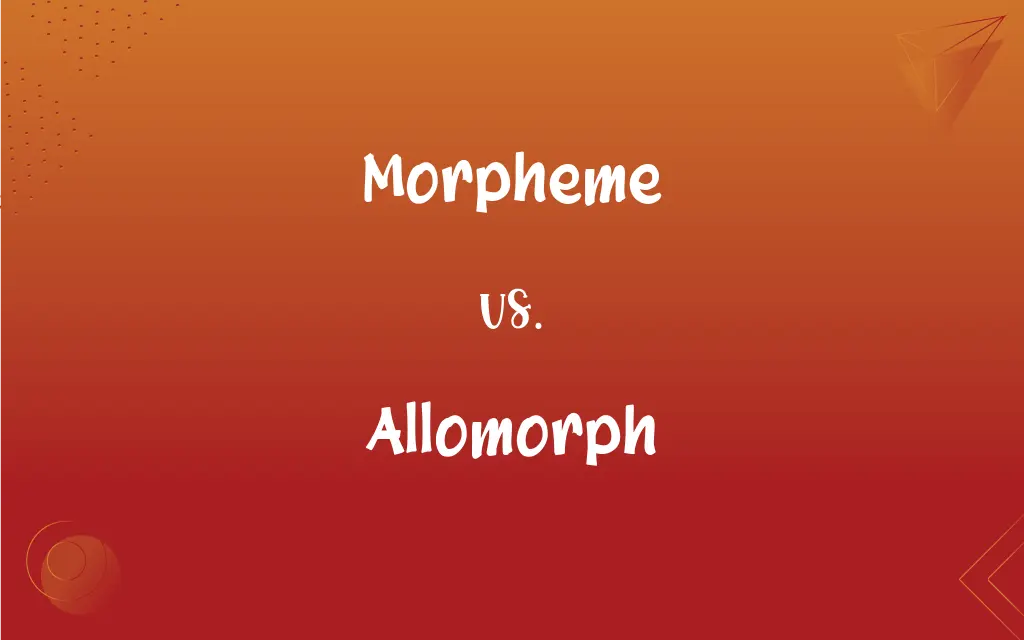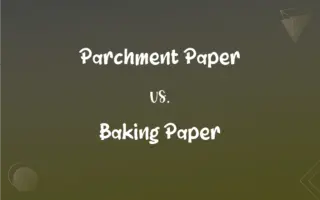Morpheme vs. Allomorph: What's the Difference?
Edited by Aimie Carlson || By Janet White || Published on March 4, 2024
A morpheme is the smallest meaningful unit in a language, while an allomorph is a variant form of a morpheme.

Key Differences
A morpheme is the smallest grammatical unit in a language that carries meaning. It cannot be divided into smaller meaningful parts without losing or altering its meaning. Allomorphs, on the other hand, are variations of a morpheme that appear in different environments but do not change the intrinsic meaning of the morpheme itself. For example, the morpheme for past tense "-ed" in English can have allomorphs that sound like /t/, /d/, or /ɪd/, as in "asked", "called", and "needed".
Morphemes are foundational elements of language, essential for constructing words. They can be free, meaning they can stand alone as words (such as "book"), or bound, meaning they must be attached to other morphemes to convey meaning (such as the plural "-s" in "books"). Allomorphs represent the diversity within morphemes, showing how the same morpheme can have different phonetic expressions. The choice of allomorph can be influenced by phonological, morphological, or syntactic rules.
The concept of a morpheme is central to understanding how meaning is structured and conveyed in language. It is a crucial tool for linguists studying the building blocks of words and sentences. Allomorphs add a layer of complexity, demonstrating the fluidity and adaptability of language, as they allow morphemes to fit phonetically and grammatically into different word environments.
Understanding the relationship between morphemes and allomorphs is key to analyzing linguistic forms and their functions. While a morpheme is a constant entity in terms of the meaning it represents, its allomorphs are variable expressions that adapt to specific linguistic contexts without altering the underlying meaning. This adaptability is essential for the phonetic cohesion and syntactic compatibility of words within a language.
Morphemes are the indivisible units of meaning in language, allomorphs are their context-dependent variants. This distinction is fundamental in linguistics, enabling a deeper understanding of language structure and the dynamics of linguistic variation.
ADVERTISEMENT
Comparison Chart
Definition
Smallest meaningful unit in language.
Variant forms of a morpheme.
Function
Carries meaning and contributes to word structure.
Reflects phonological or morphological variation within a morpheme.
Variability
Constant in meaning.
Variable in form, depending on linguistic context.
Examples
"Book", "-s" (plural), "-ed" (past tense).
/t/, /d/, /ɪd/ for the past tense "-ed".
Independence
Can be free (stand alone) or bound (needs to attach to another morpheme).
Cannot exist independently, always a variation of a morpheme.
ADVERTISEMENT
Morpheme and Allomorph Definitions
Morpheme
The smallest unit of meaning in a language.
The word cats contains two morphemes: cat and the plural -s.
Allomorph
Reflects phonetic variations without altering meaning.
The past tense -ed in hugged is pronounced /d/, an allomorph of -ed.
Morpheme
Essential for the grammatical structure of language.
The morpheme re- in rewrite indicates repetition.
Allomorph
Arises from morphological rules and phonological conditions.
The indefinite article a becomes an before a vowel sound, showing allomorphic variation.
Morpheme
Foundational element of linguistic analysis.
Happiness consists of the morpheme happy plus -ness.
Allomorph
Variant form of a morpheme that changes due to linguistic context.
The plural morpheme -s has allomorphs like /s/, /z/, and /ɪz/ in cats, dogs, and buses.
Morpheme
Integral for constructing words and sentences.
Adding the morpheme -er to teach creates teacher.
Allomorph
A variation of a morpheme that does not alter the original meaning but changes its form based on phonological or morphological conditions.
The indefinite article a becomes an before a vowel sound, demonstrating two allomorphs of the same morpheme.
Morpheme
Can be free or bound in its usage.
Unbreakable has three morphemes: un-, break, and -able.
Allomorph
Different physical forms or variations of a morpheme occurring in specific contexts without changing the morpheme's function or meaning.
In English, the plural morpheme has allomorphs /-s/, /-z/, and /-ɪz/, as seen in cats, dogs, and buses respectively.
Morpheme
A meaningful linguistic unit that cannot be divided into smaller meaningful parts. The word man and the suffix -ed (as in walked) are morphemes.
Allomorph
See paramorph.
Morpheme
(linguistic morphology) The smallest linguistic unit within a word that can carry a meaning.
Allomorph
Any of the variant forms of a morpheme. For example, the phonetic (s) of cats (kăts), (z) of pigs (pĭgz), and (ĭz) horses (hôrsĭz) are allomorphs of the English plural morpheme.
Morpheme
The smallest unit of meaning of a language, which cannot be divided into smaller parts carrying meaning; it is usually smaller than a single wordform, such as the -ed morpheme of verbs in the past tense or the -s morpheme of nouns in the plural form.
Allomorph
(chemistry) Any of the different crystalline forms of a substance.
Morpheme
Minimal meaningful language unit; it cannot be divided into smaller meaningful units
Allomorph
(linguistics) Any of the different phonological representations of a morpheme.
Allomorph
Any one of two or more distinct crystalline forms of the same substance; or the substance having such forms; - as, carbonate of lime occurs in the allomorphs calcite and aragonite.
Allomorph
Any of several different crystalline forms of the same chemical compound;
Calcium carbonate occurs in the allomorphs calcite and aragonite
Allomorph
A variant phonological representation of a morpheme;
The final sounds of `bets' and `beds' and `horses' and `oxen' are allomorphs of the English plural morpheme
FAQs
What is a morpheme?
A morpheme is the smallest grammatical unit in a language that carries meaning.
Can a morpheme be a word?
Yes, a morpheme can be a standalone word or part of a word.
Can you give an example of an allomorph?
The past tense morpheme "-ed" in English has allomorphs pronounced as /t/, /d/, and /ɪd/, as in "asked," "called," and "wanted."
What is a free morpheme example?
"Book" is an example of a free morpheme because it has meaning by itself and can stand alone as a word.
What is an allomorph?
An allomorph is a variant form of a morpheme that arises in different linguistic environments without changing the intrinsic meaning.
What distinguishes a morpheme from a syllable?
A morpheme carries meaning, while a syllable is a unit of speech sound that may or may not have meaning.
How do morphemes relate to words?
Morphemes combine to form words, either as single morphemes or multiple morphemes joined together.
What is a bound morpheme example?
"Un-" in "unhappy" is an example of a bound morpheme because it cannot stand alone and must be attached to another morpheme.
How do allomorphs affect pronunciation?
Allomorphs can change the pronunciation of morphemes depending on their phonological environment without altering the meaning.
Can the concept of allomorphs apply to all languages?
Yes, while the specifics may vary, the concept of morphological variation represented by allomorphs is applicable in many languages.
What are the types of morphemes?
There are two main types: free morphemes, which can stand alone, and bound morphemes, which must be attached to other morphemes.
Can a word have more than one morpheme?
Yes, words can be composed of multiple morphemes, such as "unbelievable," which has three morphemes: un-, believe, and -able.
What role do morphemes play in linguistics?
Morphemes are fundamental in understanding the structure, formation, and meaning of words in linguistics.
What is an example of a derivational morpheme?
"Ness" in "happiness" is a derivational morpheme that changes the adjective "happy" into a noun.
Can allomorphs change over time in a language?
Yes, allomorphs can evolve due to linguistic change, shifts in pronunciation, and other factors influencing language development.
How are morphemes identified in a language?
Morphemes are identified through their ability to convey meaning and through morphological analysis of word formation.
How does context affect allomorph selection?
The selection of an allomorph can be influenced by phonological, morphological, or syntactic context within a sentence.
Are allomorphs predictable in a language?
Allomorphs often follow specific phonological or grammatical rules, making them somewhat predictable within a language.
What is the difference between inflectional and derivational morphemes?
Inflectional morphemes modify a word's tense, number, aspect, mood, or gender without changing its grammatical category, while derivational morphemes change the meaning or part of speech of a word.
Why is the study of morphemes important in language learning?
Understanding morphemes helps in grasping the meaning and construction of words, aiding vocabulary expansion and grammatical comprehension.
About Author
Written by
Janet WhiteJanet White has been an esteemed writer and blogger for Difference Wiki. Holding a Master's degree in Science and Medical Journalism from the prestigious Boston University, she has consistently demonstrated her expertise and passion for her field. When she's not immersed in her work, Janet relishes her time exercising, delving into a good book, and cherishing moments with friends and family.
Edited by
Aimie CarlsonAimie Carlson, holding a master's degree in English literature, is a fervent English language enthusiast. She lends her writing talents to Difference Wiki, a prominent website that specializes in comparisons, offering readers insightful analyses that both captivate and inform.






































































